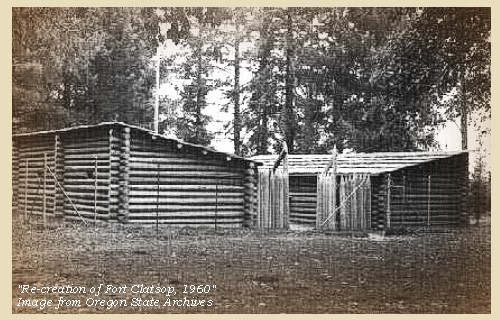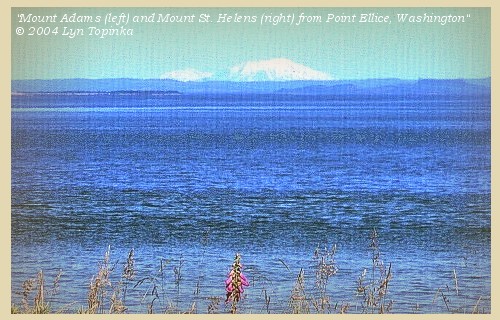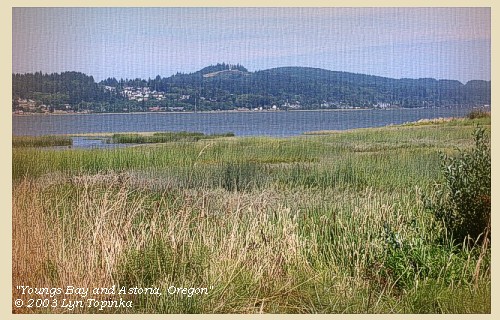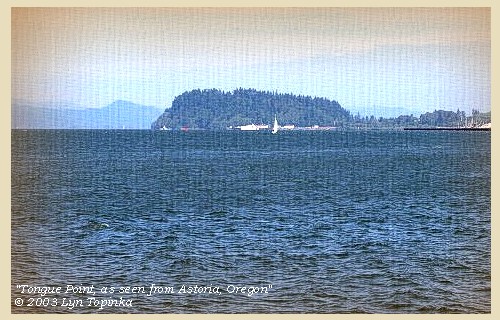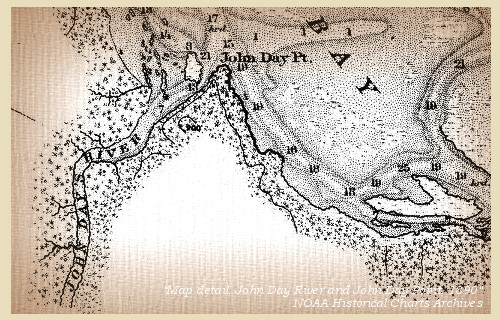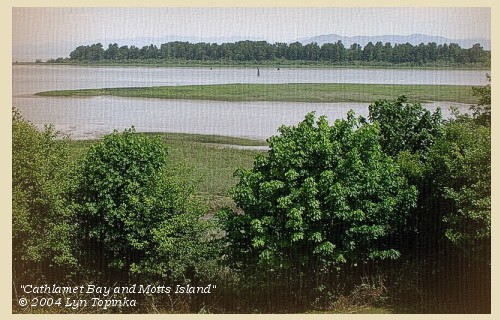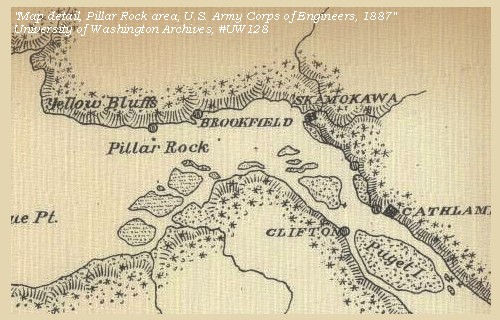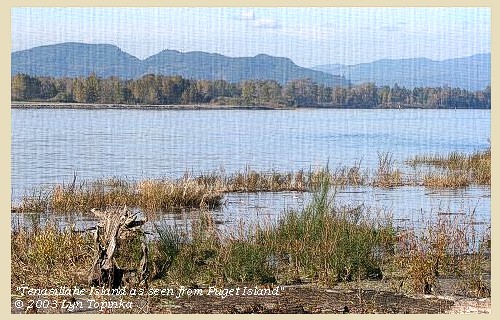The Volcanoes of
Lewis and Clark
Lewis and Clark
|
March 23 - 24, 1806 Heading Home - Fort Clatsop to Tenasillahe Island |
|
Home
The Volcanoes of Lewis and Clark Map of the Journey Volcanoes, Basalt Plateaus, Major Rivers, etc. The Volcanoes Mount Adams, Mount Hood, Mount Jefferson, Mount Rainier, and Mount St. Helens CALENDAR of the Journey October 1805 to June 1806 Along the Journey Pacific Northwest Maps - Columbia River, Volcanoes, Flood Basalts, Missoula Floods, Geology, etc. The Corps of Discovery The Journey of Lewis and Clark About the Reference Materials The Journals, Biddle/Allen, DeVoto, Gass, Moulton, Topo Maps, and others USGS Lewis and Clark Links Links to USGS Websites highlighting the Lewis and Clark Journey Resources Publications Referenced and Websites Visited |
PREVIOUS
December 7-25, 1805 A Place to Winter, Tongue Point to Fort Clatsop |
March 23-24
Heading Home, Fort Clatsop to Tenasillahe Island Fort Clatsop National Memorial, Mount St. Helens and Mount Adams, Rain and More Rain, Youngs Bay, Tongue Point, John Day River (Clatsop County), Cathlamet Bay and the Lewis and Clark NWR, Cathlamet Point - Aldrich Point, Tenasillahe Island |
CONTINUE
March 25-28 Heading Home, Puget Island to Deer Island |
|
Heading for Home - March 1806
Back on the Columbia - Fort Clatsop to Tenasillahe Island |
| Lewis and Clark wintered at Fort Clatsop, near the mouth of the Columbia River. Today the Fort Clatsop National Memorial is a reconstruction of Lewis and Clarks winter quarters. On March 23, 1806, they began their journey home. |
| Sunday, March 23, 1806 |
| The canoes were loaded, and at one o'clock in the afternoon we took a final leave of fort Clatsop. |
| "... at 1 P.M. we bid a final adieu to Fort Clatsop ..." [Lewis, March 23, 1806] |
| On a clear day, Mount St. Helens and Mount Adams are visible from the mouth of the Columbia River. |
| The wind was still high, but the alternative of remaining without provisions was so unpleasant, that we hoped to be able to double point William [Tongue Point, see below]. |
| "... This morning proved so raney and uncertain that we were undetermined for some time whether we had best set out & risque the [tide] which appread to be riseing or not. the rained seased and it became fair about Meridian, at which time we loaded our canoes & at 1 P. M. left Fort Clatsop on our homeward bound journey. at this place we had wintered and remained from the 7th of Decr. 1805 to this day and have lived as well as we had any right to expect, and we can say that we were never one day without 3 meals of some kind a day either pore Elk meat or roots, notwithstanding the repeated fall of rain which has fallen almost constantly since we passed the long narrows ..." [Clark, March 23, 1806] |
|
|
|
Rain:
The dominate physiographic features of the Pacific Northwest are the Pacific Ocean, the Coast and Cascade Mountain Ranges, and the Columbia River Basin. The Pacific Ocean is the source of all moisture entering this region. The mountain ranges cross the region in a roughly north-south direction. As storms are driven by the prevailing westerly winds, the mountains force the removal of moisture from the airmass, as indicated by the higher rainfall west of the mountains than in east-side valleys. The Coast Range (excluding the Olympic Mountains), with a few peaks that extend above 3,000 feet, generally lies within 20 miles of the Pacific Ocean. -- U.S. Army Corps of Engineers Website, 2002 Rain at Fort Clatsop: Fort Clatsop has a wet, mild climate. Annual precipitation in the vicinity of the Fort Clatsop National Memorial from 1953 through 1990 averaged 69.60 inches, most in the form of rainfall. Approximately 47 per cent of annual precipitation occurs during November, December, and January. Although actual precipitation is lower during the remainder of the year, clouds and fog are common in all months. -- U.S. National Park Service, Fort Clatsop National Memorial Website, 2002 Rain in the Coast Range: The Coast Ranges, which border the entire west coast of the United States from the Olympic Peninsula south to Mexico, vary greatly in both rock type and climate. Upper Mesozoic and Tertiary sedimentary rocks predominate, although intrusive and metamorphic rocks are also present. Most rocks have been folded, faulted, and in places intensely sheared; many of the Tertiary rocks are poorly consolidated. Topography is mountainous, with steep slopes and intervening flat valleys. Precipitation in the Coast Ranges is seasonal, ranging from very wet in parts of the northern ranges to semiarid in the south, with periodic storms accompanied by intense rainfall. The combination of steep slopes, soft, sheared rocks, and periods of heavy precipitation makes this subdivision, particularly in California, one of the most landslide prone areas of the United States. Tectonic melange, especially that of the Franciscan assemblage, is especially slide prone; landslides on natural slopes are common in all three categories of slide, fall, and flow. Debris flows during rainstorms are a particular hazard in southern California, where much of the area is heavily developed, so that many landslides have been artificially activated. The Coast Ranges are seismically active, and earthquakes have triggered many landslides. -- Radbruch-Hall, et.al., 1982, USGS Professional Paper 1183 |
| We had scarcely left the fort when we met Delashelwilt, and a party of twenty Chinnooks, who understanding that we had been trying to procure a canoe, had brought one for sale. Being, however, already supplied, we left them, and after getting out of Meriwether's bay [Youngs Bay], began to coast along the south side of the river: |
| we doubled point William [Tongue Point] without any injury, |
| and at six o'clock reached, at the distance of sixteen miles from fort Clatsop, the mouth of a small creek [John Day River, in Clatsop County], where we found our hunters. |
| They had been fortunate enough to kill two elk, but at such a distance that we could not send for them before the next morning, |
|
|
|
The Camp - March 23, 1806:
On the Oregon side of the Columbia River, between Tongue Point and the John Day River (Clatsop County), across from today's Lewis and Clark National Wildlife Refuge. |
| Monday, March 24, 1806 |
| The country is covered with a thick growth of timber: the water however is shallow to the distance of four miles from shore [they are in Cathlamet Bay]; and although there is a channel deep enough for canoes on the south side [South Channel], yet as the tide was low, we found some difficulty in passing along. [Cathlamet Bay in the vicinity of Knappa, Oregon, and is part of the Lewis and Clark National Wildlife Refuge.] |
| "... the tide being out this morning we found some difficulty in passing through the bay below the Cathlahmah village; this side of the river is very shallow to the distance of 4 miles from the shore tho' there is a channel sufficient for canoes near S. side. ..." [Lewis, March 24, 1806] |
| At one o'clock we reached the Cathlamah village, where we halted for about two hours, and purchased some wappatoo and a dog for the invalids. This village we have already described, [see November 26, 1805 entry] as situated opposite to the seal islands [Lewis and Clark National Wildlife Refuge]: ...... On resuming our route among the seal islands [Lewis and Clark National Wildlife Refuge], we mistook our way, which an Indian observing, he pursued us and put us into the right channel. ...... We continued our route along the shore, and after making fifteen miles encamped at an old village of nine houses [northeast of Brownsmead, Oregon, at Aldrich Point], |
| opposite to the lower village of the Wahkiacums [lower end of Tenasillahe Island]. |
| Here we were overtaken by two Chinnooks, who came to us after dark, and spent the night at our camp. We found plenty of wood for fires, which were quite necessary, as the weather had become cold. |
|
|
|
The Camp - March 24, 1806:
Having spent the day travelling through what is today's Lewis and Clark National Wildlife Refuge, the Corps camped on the Oregon side of the Columbia, northeast of Brownsmead, at Aldrich Point, across from Tenasillahe Island. |
| Home | Previous | Continue |
If you have questions or comments please contact: GS-CVO-WEB@usgs.gov
June/July 2004, Lyn Topinka
The Volcanoes of Lewis and Clark Home Page | CVO Home Page


